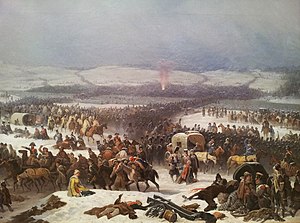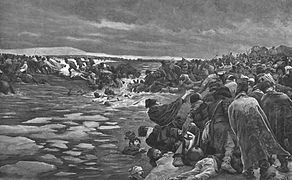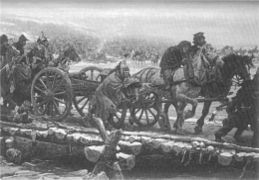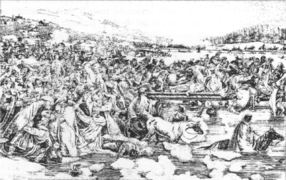利用者:Iso10970/下書き2
 |
ここはIso10970さんの利用者サンドボックスです。編集を試したり下書きを置いておいたりするための場所であり、百科事典の記事ではありません。ただし、公開の場ですので、許諾されていない文章の転載はご遠慮ください。
登録利用者は自分用の利用者サンドボックスを作成できます(サンドボックスを作成する、解説)。 この利用者の下書き:User:Iso10970/sandbox・User:Iso10970/下書き1・User:Iso10970/下書き2・User:Iso10970/下書き3User:Iso10970/下書き4 その他のサンドボックス: 共用サンドボックス | モジュールサンドボックス 記事がある程度できあがったら、編集方針を確認して、新規ページを作成しましょう。 |
| ベレジナ川の戦い | |||||||
|---|---|---|---|---|---|---|---|
| 1812年ロシア戦役中 | |||||||
 ナポレオンのベレジナ川渡河 January Suchodolski作。1866年 ポズナニの国立美術館所蔵 | |||||||
| |||||||
| 衝突した勢力 | |||||||
|
|
| ||||||
| 指揮官 | |||||||
|
|
| ||||||
| 戦力 | |||||||
|
兵士49,000人、 落伍者40,000人[5] |
兵士64,000人 うち、チチャゴフ軍:34,000人; ヴィトゲンシュテイン軍:30,000人[5] | ||||||
| 被害者数 | |||||||
|
兵士13,000-25,000人 落伍者10,000-20,000人 大砲25門 | 兵士6,000-20,000人 | ||||||
ベレジナ川の戦い(ベレジナがわのたたかい、(Battle of Berezina(またはBeresina))は、1812年11月26日から29日にかけて、ロシア遠征から退却しベレジナ川(現在のベラルーシ共和国ボリソフ近郊)を渡河しようとするナポレオン1世率いるフランス軍と、 ミハイル・クトゥーゾフ、ピョートル・ヴィトゲンシュテイン、パベル・チチャゴフ提督率いるロシア軍との間で行われた戦闘である。戦いの結果は得失両方の結果となった。フランス軍は大損害を被ったものの、辛うじて渡河することができ、袋のネズミにならずに済んだ。これ以来、「Bérézina」はフランス語で「災害」の同義語として用いられるようになった。
戦闘前の状況
[編集]大陸軍の生き残りが西方の安全地帯へ向けて戦い続けていたが、ロシア軍は肉薄していた。
フランス軍は2週間前のクラスノイの戦いで敗北していた。しかしナポレオンがロシアに侵攻する間、ベレジナ近くに配置されていた増援により、大陸軍の戦力は戦闘可能なフランス兵が3万ないし4万人まで回復し、そのほか4万人の非戦闘員がいた。ロシア軍はベレジナに約61,000人おり、そのほか40マイル東に川へ接近中のクトゥーゾフ軍54,000人がいた。
戦闘と渡河
[編集]ロシア軍がフランス軍を捕捉し壊滅させようとしているのに対し、ナポレオンはベレジナ川を渡りポーランドへ向かうこと目指していた。凍結した川を素早く渡河するという当初の計画は、いつもは凍結している氷が解けたため、不可能となった。
ボリソフの橋はすでに破壊され、船橋の建設資材も数日前に破壊されていた。フランス軍にとって幸運なことに、船橋工兵隊のジャン=バティスト・エブレ将軍が装備を廃棄せよというナポレオンの命令に背き、大事な炉や炭、工具類を取っておいていた。そこで必要なのは、川の西岸をチチャゴフの軍から守ることだけであった[6]。
ニコラ・ウディノ元帥がチチャゴフを南へ遠ざける任務を与えられた。計画通りに進み、エブレ配下のオランダ人工兵が命綱となる100メートルの橋を建設するため、冷たい川に勇敢に立ち向かった。後衛は4個スイス人連隊が務めた。騎兵が素早く橋を渡り、橋頭堡を維持するため歩兵が続いた。スイス人部隊は甚大な損害を被った(ウディノの軍団の4個スイス人連隊で生存者は300人だけであった)が、なんとか守り切り退却を助けた。この奮闘は「ベレジナリード(Beresinalied)」という詩に描かれた。スイス人部隊の英雄的な防御はフランス軍部隊の大半を救った。
数時間後、第二の橋が架かり、大砲が防衛線を支援するため渡河した。それらはチチャゴフが誤りに気付き11,000人のフランス軍を攻撃したとき、ちょうど到着した。
27日昼、ナポレオンと皇帝近衛隊 が渡河し、作戦はヴィトゲンシュタインの軍と戦っているスイス人部隊の後衛の救出に移った。
午後遅くに橋の1つが壊れたが、工兵の早業で夜の早い時間に修理された。ルイ=ニコラ・ダヴーとウジェーヌ・ド・ボアルネの軍団が渡河し、敵を防ぐためクロード・ヴィクトル=ペランの第9軍団が東岸に残った。
川越しの砲兵の支援を受けて、ヴィクトルは真夜中まで守り続けた。友軍と合流し、チチャゴフを撃退しフランスへの退却を続けることができるようになる Boosting his firepower with artillery from across the river, Victor held out until after midnight, when his forces were able to join their colleagues, push Chichagov aside, and continue the retreat to France.
損害
[編集]

両軍ともに損害については大きく意見が分かれている。
There is considerable disagreement regarding the numbers of casualties on both sides. While some 22,000 French men became casualties, these included a great number of stragglers, many of them civilians.[7] A higher estimate is provided by historian Jacques Garnier, who places French losses at 25,000 combatants, 25 cannon and 20,000 civilian stragglers, of which around 10,000 were massacred by Cossacks.[5] Russian casualties were also high, and although a very moderate 19th century Russian estimate places them at 6,000[8] they probably amounted to 20,000 men.[5] Historian Alain Pigeard offers more moderate figures (combatants only): between 13,000 and 16,000 men (2000 killed, 7,000-10,000 wounded, plus the entire Partouneaux division killed, wounded or prisoners) for the French, 13,000 men (10,000 dead or wounded, 3,000 prisoners on the right bank) for the Russians. Among the French casualties were three generals and four colonels, killed during this battle.[9] Pigeard's estimate reflects more recent research, with most modern historians placing French losses at around 15,000 combatants and 10,000 stragglers. Russian losses are usually placed at up to 15,000 combatants.[10] According to the modern Russian encyclopedia, the Russian army lost from 8,000 to 15,000 killed, wounded and prisoners during four days; French casualties were from 25,000 to 40,000 [11] Richard K. Riehn estimated French losses at about 30,000; most of these were stragglers, actual battle losses being relatively small with about 10,000 French and 14,000 Russians actually involved.[12]
登場する作品
[編集]ベレジナ川の戦いは、1956年の映画「戦争と平和」の中で描かれている。
画像
[編集]The drama of the battle's story inspired many works of art centred on the crossing.
-
Crossing of the Berezina, Felician Myrbach
-
Le passage de la Bérézina, Joseph Raymond Fournier-Sarlovèze
-
Crossing the Berezina River on 17 November 1812, Peter von Hess
-
La traversée de la Bérézina en 1812, Jan Hoynck van Papendrecht
-
Crossing at Berenzina, Julian Fałat
-
Übergang über die Berezina, unknown
関連項目
[編集]脚注
[編集]- ^ Chandler, p. 1026.
- ^ Zamoisky, p. 480.
- ^ Riehn, p.387.
- ^ Clausewitz, Karl Riehn, p.387
- ^ a b c d Tulard, volume 1, p. 202-203.
- ^ Beresina : Battle of the Beresina : Napoleonic Wars : Retreat from Russia 1812 : Napoleon Bonaparte
- ^ Marley, E. J. La Méthode Graphique (Paris, 1885) (as cited in Tufte, Edward R.'s The Visual Display of Quantitative Information)
- ^ Богданович М. И., История Отечественной войны 1812 года по достоверным источникам. Т.3.-СПБ.,1860
- ^ Pigeard, p.125-126.
- ^ Moscow, 1812: Napoleon's Fatal March on Moscow, Adam Zamoyski, Harper/Collins, 2004, ISBN 0-06-108686-X, page 480.
- ^ Отечественная война 1812 года. Энциклопедия. - М., РОССПЭН, 2004, стр.65
- ^ Riehn, p.387
参考文献
[編集]- Morelock, Jerry, Napoleon’s Russian nightmare. Misjudgments, Russian strategy and “General Winter” changed the course of history, 2011
- Weider, Ben and Franceschi, Michel, The Wars Against Napoleon: Debunking the Myth of the Napoleonic Wars, 2007
- Zamoyski, Adam, 1812: Napoleon’s Fatal March on Moscow, 1980
- Chandler, David, The Campaigns of Napoleon New York, Macmillan, 1966
- Tulard, Jean - "Dictionnaire Napoléon”; Librairie Artème Fayard, 1999, ISBN 2-213-60485-1
- Pigeard, Alain - "Dictionnaire des batailles de Napoléon", Tallandier, Bibliothèque Napoléonienne, 2004, ISBN 2-84734-073-4
- Pigeard, Alain - "La Bérézina", Napoléon Ier Editions 2009
- http://mastersofthefield.com/ew_map_information/Berezina_Read_First.htm
- Mikaberidze, Alexander (2010). Napoleon's Great Escape: The Battle of the Berezina. London: Pen and Sword. ISBN 978-1-84415-920-8
en:Template:Napoleonic Wars 座標: 北緯54度19.550分 東経28度21.631分 / 北緯54.325833度 東経28.360517度
-->







